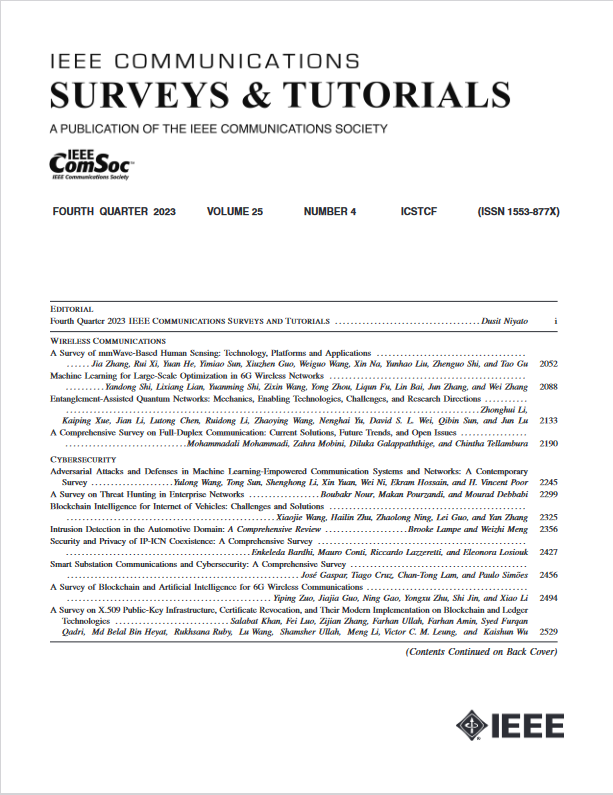A Survey on X.509 Public-Key Infrastructure, Certificate Revocation, and Their Modern Implementation on Blockchain and Ledger Technologies
IF 34.4
1区 计算机科学
Q1 COMPUTER SCIENCE, INFORMATION SYSTEMS
引用次数: 1
Abstract
Cyber-attacks are becoming more common against Internet users due to the increasing dependency on online communication in their daily lives. X.509 Public-Key Infrastructure (PKIX) is the most widely adopted and used system to secure online communications and digital identities. However, different attack vectors exist against the PKIX system, which attackers exploit to breach the security of the reliant protocols. Recently, various projects (e.g., Let’s Encrypt and Google Certificate Transparency) have been started to encrypt online communications, fix PKIX vulnerabilities, and guard Internet users against cyber-attacks. This survey focuses on classical PKIX proposals, certificate revocation proposals, and their implementation on blockchain as well as ledger technologies. First, we discuss the PKIX architecture, the history of the World Wide Web, the certificate issuance process, and possible attacks on the certificate issuance process. Second, a taxonomy of PKIX proposals, revocation proposals, and their modern implementation is provided. Then, a set of evaluation metrics is defined for comparison. Finally, the leading proposals are compared using 15 evaluation metrics and 13 cyber-attacks before presenting the lessons learned and suggesting future PKIX and revocation research.X.509公钥基础设施、证书撤销及其在区块链和分类账技术上的现代实现的调查
由于人们在日常生活中越来越依赖在线交流,针对互联网用户的网络攻击变得越来越普遍。X.509公钥基础设施(PKIX)是最广泛采用和使用的系统,用于保护在线通信和数字身份。然而,针对PKIX系统存在不同的攻击向量,攻击者利用这些攻击向量来破坏依赖协议的安全性。最近,各种项目(例如Let’s Encrypt和b谷歌Certificate Transparency)已经开始加密在线通信,修复PKIX漏洞,保护互联网用户免受网络攻击。本调查的重点是经典的PKIX提案,证书撤销提案,以及它们在区块链和分类账技术上的实现。首先,我们讨论了PKIX体系结构、万维网的历史、证书颁发过程以及对证书颁发过程可能的攻击。其次,提供了PKIX提案、撤销提案及其现代实现的分类。然后,定义一组评价指标进行比较。最后,在提出经验教训并建议未来的PKIX和撤销研究之前,使用15个评估指标和13个网络攻击对领先的提案进行了比较。
本文章由计算机程序翻译,如有差异,请以英文原文为准。
求助全文
约1分钟内获得全文
求助全文
来源期刊

IEEE Communications Surveys and Tutorials
COMPUTER SCIENCE, INFORMATION SYSTEMS-TELECOMMUNICATIONS
CiteScore
80.20
自引率
2.50%
发文量
84
审稿时长
6 months
期刊介绍:
IEEE Communications Surveys & Tutorials is an online journal published by the IEEE Communications Society for tutorials and surveys covering all aspects of the communications field. Telecommunications technology is progressing at a rapid pace, and the IEEE Communications Society is committed to providing researchers and other professionals the information and tools to stay abreast. IEEE Communications Surveys and Tutorials focuses on integrating and adding understanding to the existing literature on communications, putting results in context. Whether searching for in-depth information about a familiar area or an introduction into a new area, IEEE Communications Surveys & Tutorials aims to be the premier source of peer-reviewed, comprehensive tutorials and surveys, and pointers to further sources. IEEE Communications Surveys & Tutorials publishes only articles exclusively written for IEEE Communications Surveys & Tutorials and go through a rigorous review process before their publication in the quarterly issues.
A tutorial article in the IEEE Communications Surveys & Tutorials should be designed to help the reader to become familiar with and learn something specific about a chosen topic. In contrast, the term survey, as applied here, is defined to mean a survey of the literature. A survey article in IEEE Communications Surveys & Tutorials should provide a comprehensive review of developments in a selected area, covering its development from its inception to its current state and beyond, and illustrating its development through liberal citations from the literature. Both tutorials and surveys should be tutorial in nature and should be written in a style comprehensible to readers outside the specialty of the article.
 求助内容:
求助内容: 应助结果提醒方式:
应助结果提醒方式:


